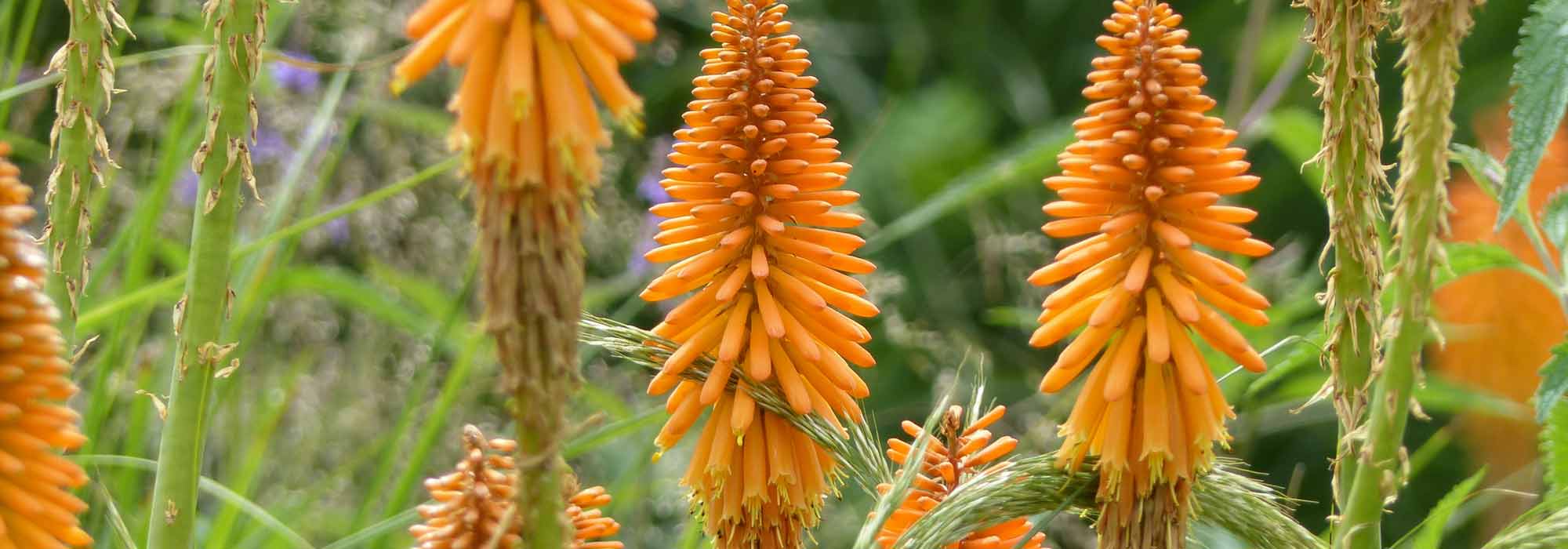
Kniphofia, Red hot poker : planting, growing and care
Contents
Kniphofia in a nutshell
- Kniphofia is an imposing, regal perennial with spectacular and flamboyant flowering
- These yellow, red, or orange “red hot pokers” that persist from June to October attract a ballet of pollinators throughout the summer
- Easy to grow and maintain, it thrives in full sun in any well-drained soil
- It is very hardy, even in the coldest regions, provided the stump is mulched
- With its exotic touch, it warms and structures vicarage gardens, contemporary gardens, or cottage borders
A word from our expert
The Kniphofia or red hot poker, sometimes referred to as “false aloe”, is a remarkable perennial. It offers a long, vibrant flowering display, ranging from orange to yellow, with creamy white, beautifully highlighted by its elegant foliage. Once out of fashion, it is making a strong comeback, and rightly so, as it is an excellent perennial plant for borders, with a tall and graphic habit, essential for brightening up borders, rockeries, and containers throughout the summer.
Ranging in height from 50 cm to 1.20 m, kniphofia helps to structure the somewhat flat beds of vicarage gardens, naturalistic gardens, as well as contemporary gardens, where they ignite colourful torches throughout the beautiful season.
From kniphofia uvaria ‘grandiflora’ with its flowers transitioning through shades of orange, to the classic variety Kniphofia “Royal Standard” with bicoloured yellow and red flowers, all tritomas are surprising, robust plants that have already charmed our grandmothers, bringing an exotic touch that is very refreshing to the garden.
With its exotic appearance, the Kniphofia, known as “devil’s poker” or “Satan’s poker”, reveals a great hardiness, able to withstand our rather cold winters (-10 to -15°C).
Kniphofia in yellow, red, orange, and sometimes green and white, attract pollinating insects all summer long around their colourful spikes, which are also stunning in bouquets!
Easy to grow, Kniphofia requires only a well-drained soil that remains cool during the summer and a warm, sunny location, essential for abundant flowering.
Plant some exotic colour in your garden with our kniphofias in buckets and discover our easy-to-sow kniphofia seeds!
Description and botany
Botanical data
- Latin name Kniphofia, Tritoma
- Family Asphodelaceae
- Common name Red Hot Poker, Torch lily, Tritoma, False Aloe
- Flowering from June to October depending on the species
- Height 0.50 to 1.20 m
- Exposure Sun
- Soil type All, well-drained
- Hardiness -10°C to -15°C
The Kniphofia, also known as Tritoma or “Red Hot Poker” is a perennial rhizomatous plant belonging to the Asphodelaceae family, native to cool places, meadows, rocky slopes up to 2900 m, and waterways in South or East Africa.
The genus includes more than 70 deciduous and evergreen species. The most common in our gardens is the species K. uvaria, which has given rise to many hybrids and cultivars well adapted to our climates. Less commonly found in our gardens is Kniphofia rooperi, a very beautiful species of botanical Tritoma, with lustrous, ellipsoidal, and broad clusters, and Kniphofia northiae with evergreen leaves.
This rhizomatous species, also known as “False Aloe”, develops on a fleshy rhizome and forms a generous tuft with a stiff and upright habit, somewhat dishevelled. Its growth is quite rapid, even invasive.
Sizes vary according to cultivars, from 50 cm for dwarf varieties to nearly 2 m in height when in flower for giant Kniphofias.
In spring, the leaves emerge from vigorous rosettes at least 50 cm wide and develop in a fan shape, forming a beautiful flared tuft, fountain-like, with nicely drooping edges.
The shiny leaves with pointed tips and slightly sharp margins are long, gracefully arched, ribbon-like, and keeled, meaning they have prominent parallel veins and are sometimes finely dentate. Depending on the varieties, the foliage colours range from pale green, bright green to medium green, and bluish green. The deciduous species and hybrids bear leaves 10 cm to 1 m long, very fine, flexible, similar to those of grasses.
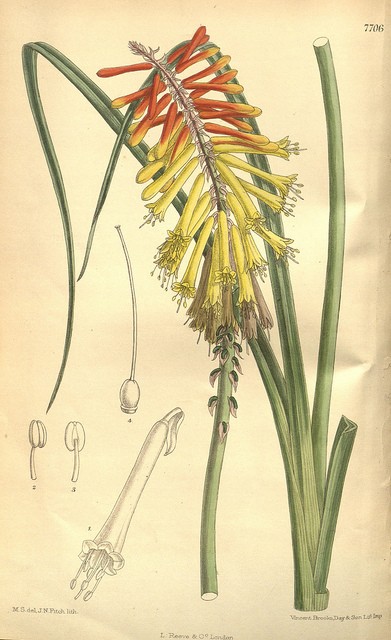
Kniphofia or Tritoma – botanical illustration
The leaves of the evergreen Kniphofias are generally more fleshy, deeply keeled or ribbon-like, 1 to 1.50 m long, and resemble those of Miscanthus. Kniphofia northiae is distinguished by its broad, smooth, glaucous evergreen leaves, similar to those of agaves.
The extraordinary flowering with exotic looks and particularly long duration of Kniphofia never goes unnoticed.
From May to October, depending on the cultivars, tall, thick floral stems emerge from this dense grassy tuft, rising quickly sometimes to over 1.50 m above the ground.
From spring to late summer, they display particularly opulent terminal inflorescences held well above the foliage on sometimes bronze-coloured bare stems. These large cylindrical or ellipsoidal flower spikes, measuring 5 to 40 cm high, in vibrant colours resemble a torch or still glowing embers, which has earned Kniphofia the nickname “devil’s poker” or “demon’s poker”.
They consist of numerous tubular and pendulous flowers, sometimes erect, lemon yellow or canary, apple green, scarlet red, coral red, or orange, measuring 3 to 50 mm long. These small bells in bright colours reveal often prominent stamens and contrast strongly against the foliage, adding extra appeal.
The flower buds open from the bottom to the top of the spike, often changing colour as they bloom; a feature that means the flower stems often bear two to three different colours. The flowers gradually change hue as they mature, starting vivid at blooming, the flowers at the base of the spike fade gently as they wither. The spike thus appears bicoloured as it matures, transitioning from vibrant colours to softer shades of cream, pale yellow to white at the base of the spike.
Withered flowers and dry flowers coexist for about a month and a half on these very dense inflorescences shaped like catkins, which hold up well in summer bouquets.
Some recent varieties are early and remontant (‘Mango Popsicle’), starting to flower as early as May for 2 months and blooming again in late summer.
Particularly melliferous and nectariferous, they irresistibly attract butterflies and bees throughout the summer.
After flowering, the flowers turn into fruits in the form of capsules that release black seeds that can self-seed spontaneously almost everywhere.
 Several colours: Kniphofia ‘Orange Vanilla Popsicle’, Kniphofia ‘Green Jade’, Kniphofia ‘Nancy’s Red’, Kniphofia ‘Mango Popsicle’, Kniphofia ‘Royal Standard’.
Several colours: Kniphofia ‘Orange Vanilla Popsicle’, Kniphofia ‘Green Jade’, Kniphofia ‘Nancy’s Red’, Kniphofia ‘Mango Popsicle’, Kniphofia ‘Royal Standard’.
Kniphofia is a fairly hardy perennial in our regions, which withstands temperatures often below -10°C. In regions with harsh winters, a good mulch will help the stump withstand frost. Kniphofia prefers cooler environments and grows in the sun in light but rich, cool and well-drained soil.
Royal and imposing, with its warm and vibrant colours and original flowering, Kniphofia inevitably attracts the eye in groups, as a solitary specimen, on a lawn or near a water feature. Well known for its structural qualities, it adds a touch of exoticism to the garden and creates a summery, exotic decor.
The tallest species structure and provide height to the centres and backgrounds of large perennial borders or mixed borders. It is a perfect plant for a very sunny contemporary garden.
Main species and varieties
There are more than 70 species of Kniphofia but the most cultivated in our climates is Kniphofia uvaria which has given rise to numerous cultivars and hybrids such as the essential Kniphofia uvaria « Grandiflora » which is the most widespread.
The height of Kniphofia varies according to the varieties, from 60 to 70 cm for the shortest species and varieties to 1 to 1.5 m in height for the tallest tritomas like Kniphofia ‘Green Jade’, offering a wide choice to enliven large borders such as beds, rockeries or pots.
Flowering extends from May, for the earliest, to October, depending on the varieties and the climate.
Long unjustly overlooked due to its garish colours, sometimes bordering on kitsch, this beautiful spectacular perennial has been making a strong comeback for about ten years thanks to the appearance of new varieties with more tangy and refreshing shades, less aggressive, such as Kniphofia ‘Mango Popsicle ©’ or Kniphofia ‘Ice Queen’.
Alongside the classic flower spikes of Kniphofia resembling glowing torches, there is now a range of varieties with green, pink, cream or even white flowers.
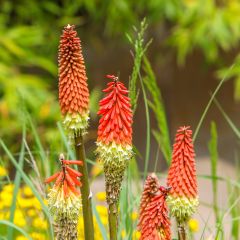
Kniphofia uvaria - Red Hot Poker
- Flowering time July to October
- Height at maturity 1 m
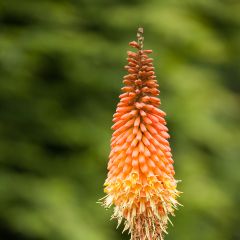
Kniphofia Royal Standard - Red Hot Poker
- Flowering time August to October
- Height at maturity 1 m
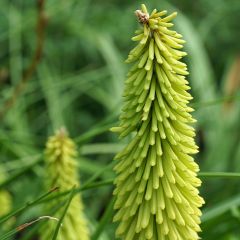
Kniphofia Green Jade - Red Hot Poker
- Flowering time August to November
- Height at maturity 1 m
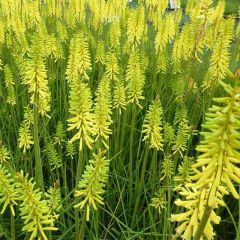
Kniphofia Vanilla - Red Hot Poker
- Flowering time August, September
- Height at maturity 1 m
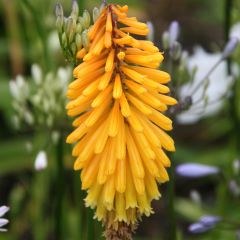
Kniphofia Mango Popsicle - Red Hot Poker
- Flowering time June to October
- Height at maturity 60 cm
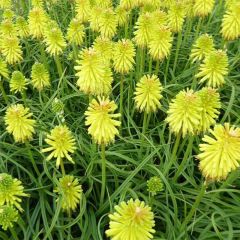
Kniphofia pauciflora Limelight - Red Hot Poker
- Flowering time August to October
- Height at maturity 60 cm
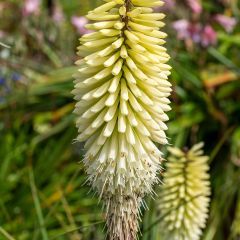
Kniphofia Ice Queen - Red Hot Poker
- Flowering time August, September
- Height at maturity 1,10 m
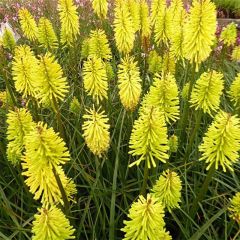
Kniphofia Dorset Sentry - Red Hot Poker
- Flowering time July to October
- Height at maturity 90 cm
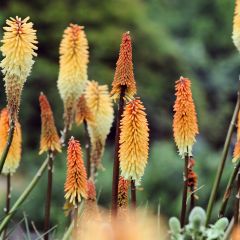
Kniphofia Tawny King - Red Hot Poker
- Flowering time August to October
- Height at maturity 1,10 m
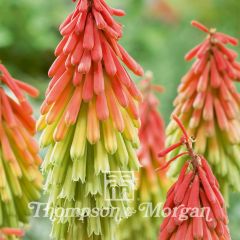
Kniphofia Traffic Lights - Red Hot Poker seeds
- Flowering time September to November
- Height at maturity 35 cm
Discover other Kniphofia - Red-Hot Pokers
View all →Available in 0 sizes
Available in 2 sizes
Available in 3 sizes
Available in 1 sizes
Available in 2 sizes
Available in 1 sizes
Available in 1 sizes
Available in 2 sizes
Available in 1 sizes
Available in 2 sizes
Planting
Where to plant kniphofias?
Native to Africa, Kniphofia thrives in warm, sunny locations and mild winters, but it acclimatises easily in all our gardens, withstanding well in our temperate regions of northern France. Hardy down to -12 to -15°C, it will bloom for many years in well-drained soil.
It has a strong aversion to heavy, wet, and poorly drained soils. While it withstands drought well, it is sensitive to wet winters: waterlogged, compacted, clayey soil would compromise its longevity. A thick mulch around the collar will be necessary in harsh and humid climates.
Don’t be fooled by its appearance! Beneath its exotic looks, kniphofia prefers light, rich soil that remains cool in summer and does not dry out.
It enjoys sunny exposures essential for abundant flowering, although it will tolerate partial shade in southern regions. In poor, dry soil, it will be disappointing and will never appear lush.
It also accepts sandy soils, tolerates wind, making it a good plant for coastal areas, ideal for seaside gardens.
Choose a location that matches its relatively broad development: its growth is quite rapid, it can quickly become invasive, often occupying more than 50 cm in width at maturity.
Used as a solitary specimen on a lawn or planted in groups, kniphofia structures the space and adds verticality and exoticism to the garden. It integrates beautifully into wild, natural gardens, as part of a large, slightly blurred perennial mass, on a raised bank, or by the edge of a pond, where it adds relief and breadth.
Sometimes it’s better to hide its delicate but occasionally slightly untidy foliage behind other plants at the front of a flower bed.
The shorter varieties fit easily at the border, in rockeries, or grown in pots on a sunny terrace.
When to plant the Torch lily?
Kniphofia is planted in spring from March to April or in autumn from September to November for a profusion of flowers in summer.
How to plant kniphofias?
In the ground
In rich, well-drained soil, kniphofias will be more vigorous and more frost-tolerant. If your soil retains moisture, plant your kniphofias at the top of a mound or on a raised bank, where water will not stagnate. In heavy soil, add compost or river sand to lighten it and ensure good drainage.
Large kniphofias should be planted in small groups of 3 or 5 per m² for a spectacular effect in a bed, spacing the plants 40 cm to 80 cm apart in all directions, depending on the varieties.
- Soak the root ball in a basin of water for a quarter of an hour before planting
- Gently untangle and scratch the roots to encourage recovery
- Dig a hole 2 to 3 times the volume of the bucket
- Loosen the soil deeply to aerate it, removing stones and weeds
- Add coarse river sand or well-draining gravel to the bottom of the hole
- Add a good handful of potting soil and well-rotted compost to the soil
- Backfill the hole, ensuring the plant is upright, with the collar level with the soil
- Create a watering basin around the base of the plant and water generously
- Add a mulch
How to plant a kniphofia in a pot
The substrate must be rich and very well-draining to avoid stagnant moisture at the roots. Place the pot in full sun. Plant the Kniphofia in a pot with a minimum diameter of 30 cm.
- Spread a good layer of gravel or clay balls for drainage
- Plant in a slightly sandy potting mix
- Mulch the base
- → Our advice sheet: Growing a Kniphofia in a pot
How to sow kniphofia seeds or tritoma?
Sowing seeds is done in March or September-October after stratifying (placing in the cold in the vegetable drawer of the refrigerator) the seeds for 6 weeks. If you sow at the end of summer, your tritoma will bloom the following summer.
- Sow under cover in trays in a warm environment between 15 and 20 °C in moist seed compost
- Cover the seeds with a few millimetres of compost
- Press down with a board
- Keep in light
- The seedlings will emerge in 14 to 30 days
- When the seedlings are 5 cm tall, transplant the young tritomas into individual pots of 7 cm
- Take them outside once the frosts have passed
- Plant the vigorous seedlings in the garden or in pots the following year in soil enriched with compost
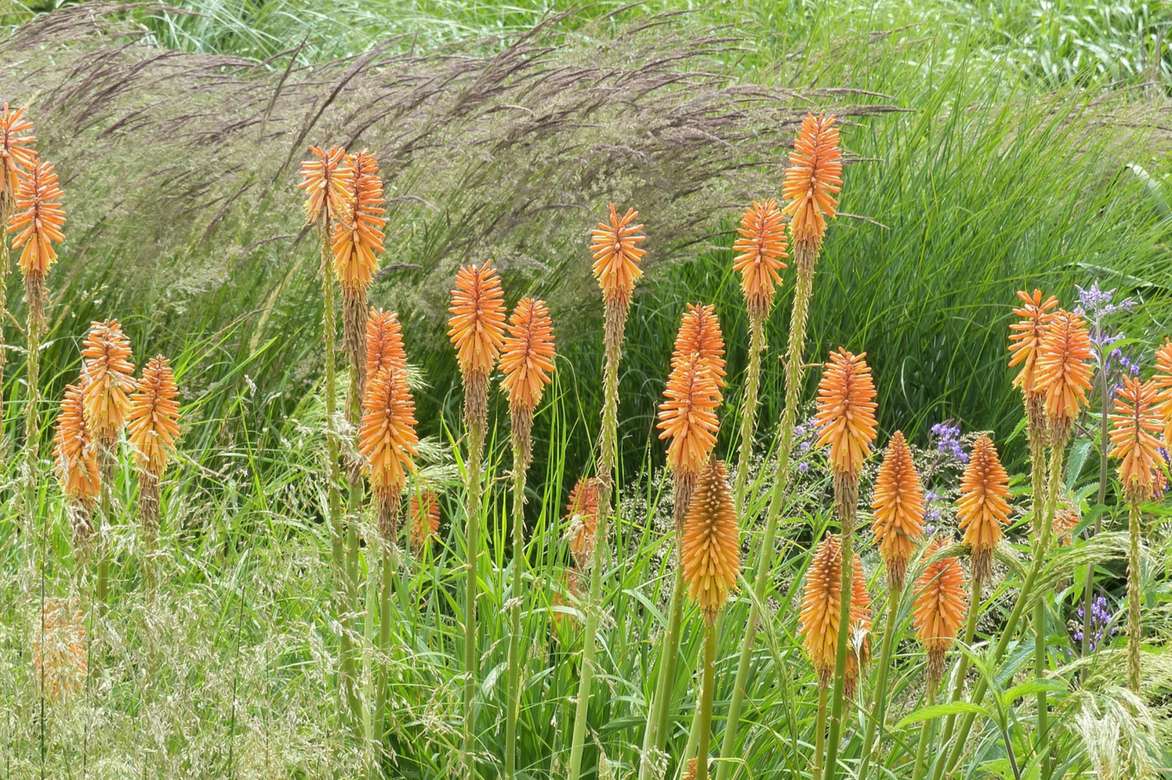
Kniphofia among grasses.
Maintenance and care
Vigorous and hardy, this perennial with fiery spikes requires little care once established. In summer, it must not lack water, especially during the first summer following planting.
Then, during the flowering period, ensure regular watering to encourage flowering. Do not let the soil dry out between waterings: the plant must remain cool. The kniphofia will tolerate a few dry spells, provided they do not last long. In winter, it does not require watering.
In poor soil, do not skimp on adding compost to see it bloom profusely.
Cut back the faded flower spikes, which are not always very attractive after flowering; this will also help prevent self-seeding, as the plant readily reseeds itself and can quickly become invasive.
As winter approaches, mulch the stumps with a layer of leaves, dry ferns, or straw to protect its roots from the cold and moisture: although hardy, Kniphofia is sensitive to severe and prolonged frosts.
In March, give it a little spring cleaning, cut back the faded stems, and trim the old foliage by half to encourage the growth of new shoots.
Clumps of Kniphofia can lose vigour as they age: every two to three years, divide the clumps to replant them elsewhere in the garden. This operation rejuvenates the clump and removes damaged parts.
If you are growing it in a pot, wrap the foliage in a winter fleece. Apply a good fertiliser each spring. Repot every 2 years.
Pests and potential diseases
The Red Hot Poker or kniphofia is a disease-resistant perennial in well-drained soil: it fears waterlogged soils in winter. Aside from the excess moisture in winter that causes root rot, if the soil is not well-drained, it has few enemies.
Kniphofia can be susceptible to a viral disease transmitted by thrips, tiny pests that cause leaf mottling. As a preventive measure, regularly watering the foliage during hot and dry weather may be enough to avoid infestations: indeed, thrips do not thrive when humidity is sufficient. Garlic decoctions combined with black soap can also be useful as a preventive measure.
Multiplication of Tritoma
Red hot pokers or kniphofia can be multiplied by sowing, but dividing the clumps in spring is a simpler method. Seeds are harvested at ripeness and sown in spring (see above “How to sow kniphofia or tritoma seeds?”), unless you have cut all the flower spikes; otherwise, purchase our kniphofia seeds.
When and how to divide kniphofia?
Dividing a large clump can be quite challenging, as the stump is very vigorous. Avoid damaging the delicate roots. Dividing tritoma clumps is done when the stump is well established, in the 3rd or 4th year after planting. Division allows for easy multiplication of the plant and helps maintain vigorous specimens.
- Using a fork, lift the clump without damaging the roots
- With a sharp, disinfected knife, separate the offsets formed around the edge of the clump and replant them immediately in the garden.
→ Learn more about multiplying kniphofia in our tutorial!
Associating the Red-hot poker
The tritoma or Kniphofia is a perennial that warms up the atmosphere all summer long! The warm and vibrant colour of its tall flower spikes irresistibly attracts the eye, creating graphical vertical accents. Imposing and stately, it thrives in naturalistic gardens, clergy gardens, contemporary meadow gardens, or in country-style beds and borders, adding height, relief, and exoticism.
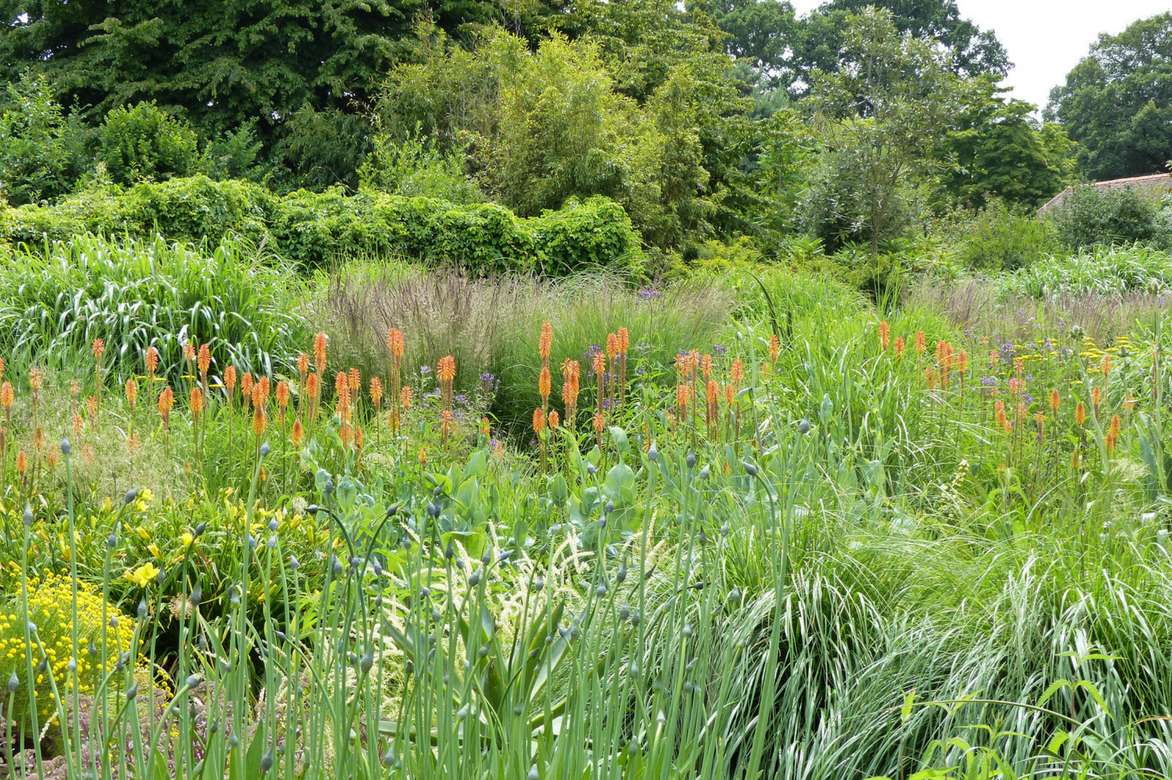
An example of a natural association of kniphofia with grasses (Calamagrostis, Miscanthus, Pennisetum, Deschampsia), daylilies like ‘Citrina‘ and Agapanthus still in bud.
It always creates flamboyant and spectacular scenes with other tall, light perennials. These fiery red or pure yellow torches beautify beds with warm and vibrant colours. The tallest should be planted in numbers for beautiful spectacular effects in well-drained beds, while the smaller ones can be scattered in a short grass meadow to dress a gravel path border, in a sunny rockery, or in pots.
Originating from the same regions and flowering at the same time, agapanthus are the ideal companions for Kniphofia, offering beautiful blue/orange or blue/cream-yellow contrasts. Kniphofia is equally effective in highlighting the presence of blue flowers, with their slender spikes of lemon-yellow flowers making a stunning effect alongside campanulas, Anchusa azurea, delphiniums such as the Belladona group cultivars, lavenders, and hardy geraniums.
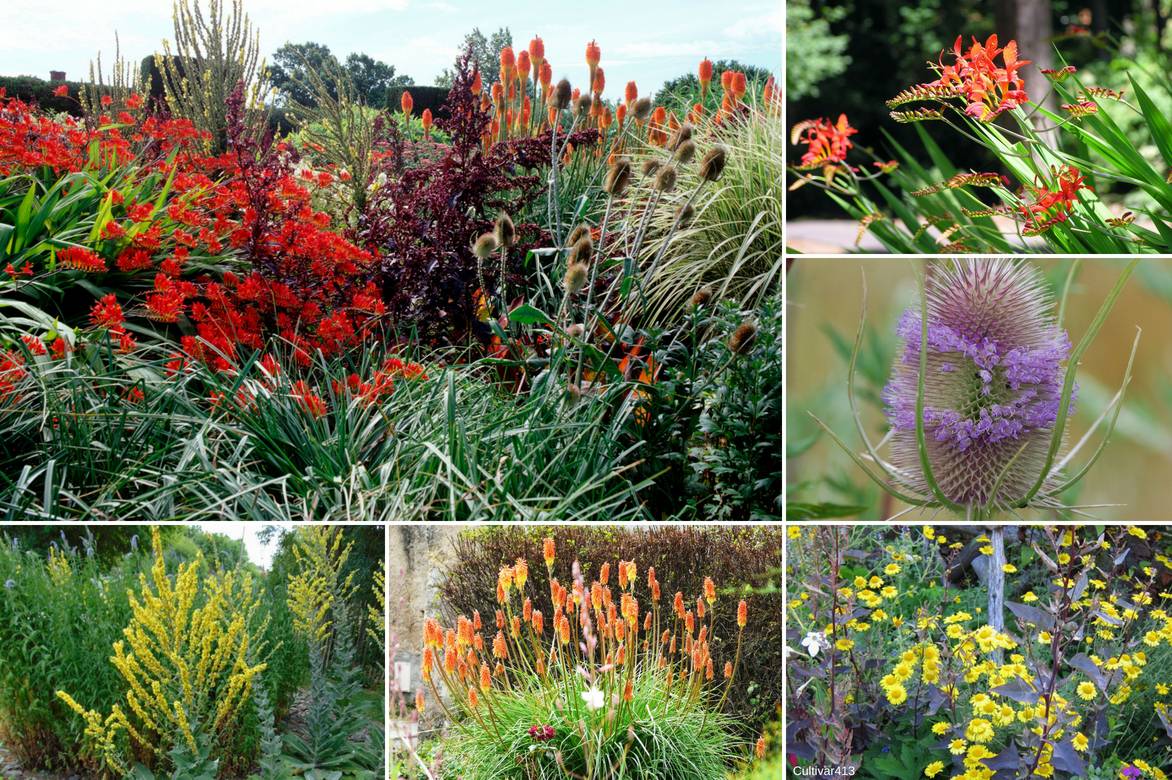
A high-colour association idea: Crocosmia ‘Lucifer’, Dipsacus sylvestris, Atriplex hortensis ‘Rubra’, Anthemis tinctoria ‘Kelwayi’, Kniphofia uvaria, Verbascum thapsus.
It lends itself to eloquent alliances with yellow-green foliage such as that of euphorbias or gold-variegated hostas.
Its bristly silhouette and upright habit contrast beautifully with round or branched flowers like those of rudbeckias, poppies, or dahlias, and the flat cymes of achilleas.
To create an exotic atmosphere, it can be associated with bamboos, yuccas, Phormium, cannas, Crocosmias, daylilies, and lobelia; its height allows it to coexist with taller plants while towering over smaller companion plants.
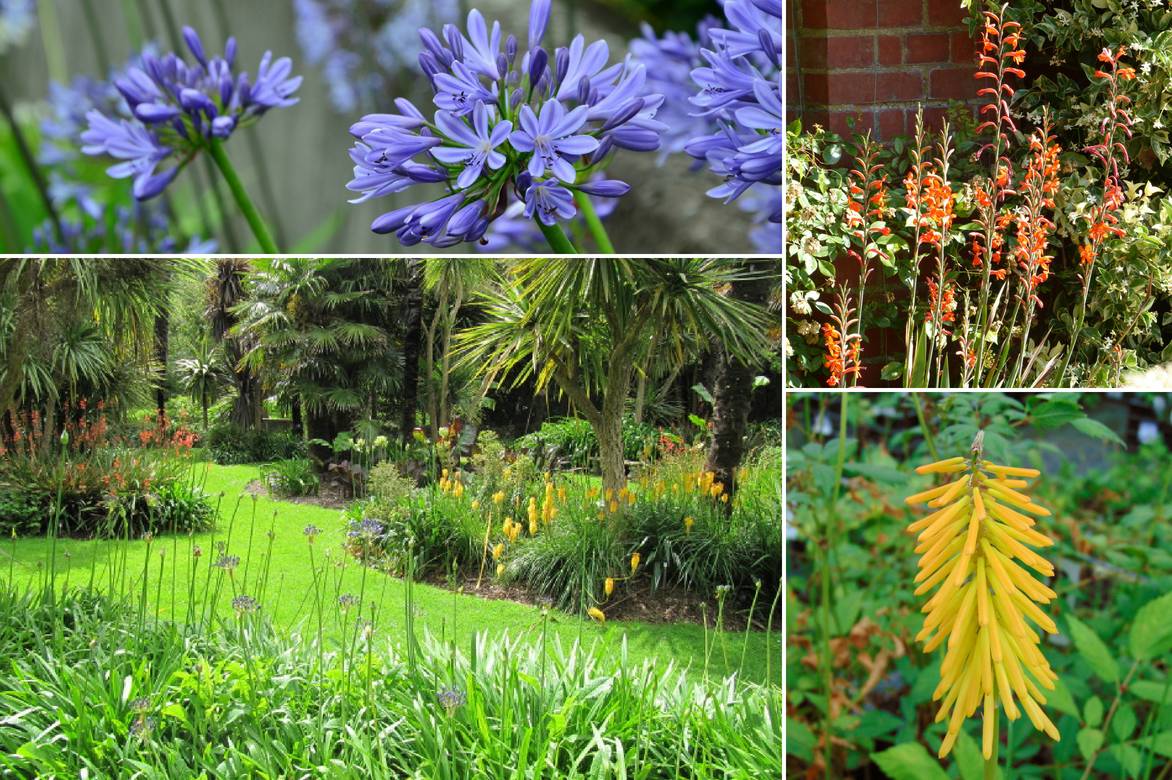
An example of an exotic association: Kniphofia ‘Mango Popsicle’, Agapanthus, Watsonia ‘Stanford Scarlet’.
But be careful of the cacophony of strong tones! Use kniphofia to enhance a bed of grasses. A few shimmering grasses like Miscanthus, tall fescues, or small Hakonechloa will complement the incandescent arrangements, calming the fire and bringing movement in contrast to the upright graphic nature of Kniphofia.
Kniphofia will integrate well into a large rockery, paired with poppies, sage, and linaria.
In a lush bed of annuals and summer-flowering perennials, it will easily associate with Inca lilies, Cape fuchsias, silver mullein, penstemons, alonsoa, agastaches, and yellow or blue alchemillas.
→ Discover 7 pairing ideas with Kniphofia in our advice sheet!
Useful resources
- Discover our guide to choosing your Kniphofia
- Find inspiration on our blog to create a beautiful perennial bed
- With Kniphofia, dare to add colour to your garden and draw from our inspirations for a colourful garden!
- Add a contemporary touch with our Red Hot Pokers in a naturalistic garden
- Discover the most beautiful varieties of Kniphofia!
- Our advice sheet: Growing a Kniphofia in a pot
- Discover 8 perennials with red flowers to set your garden ablaze!
- Subscribe!
- Contents
































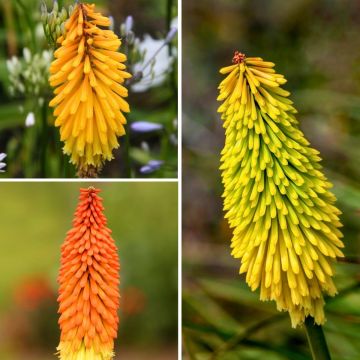
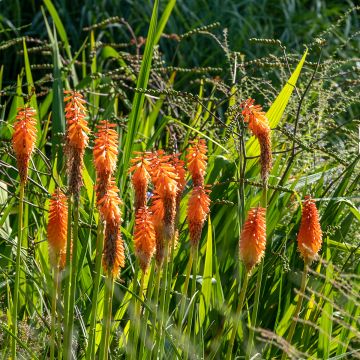

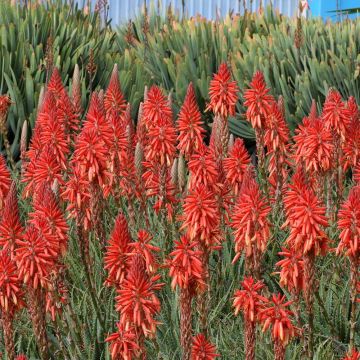

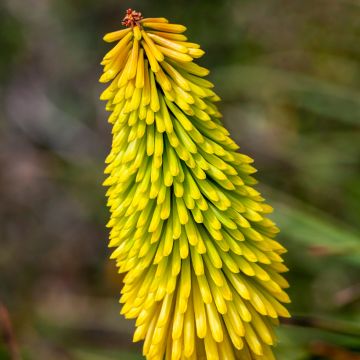
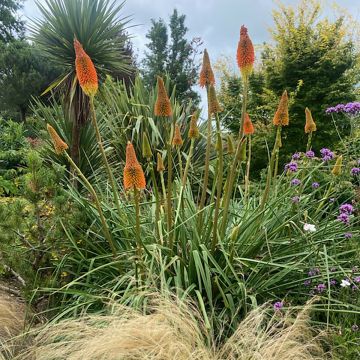
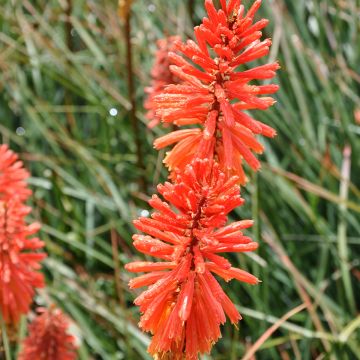


Comments